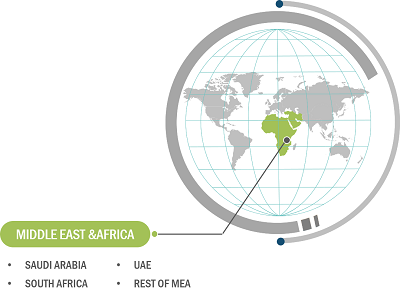Antibiotics Segment to Dominate MEA Respiratory Tract Infection Treatment Market During 2021–2031
According to our new research study on "MEA Respiratory Tract Infection Treatment Market Size and Forecast (2021–2031), Country Share, Trend, and Growth Opportunity Analysis," the market value is expected to surge from US$ 2,092.80 million in 2023 to US$ 2,795.09 million by 2031 at a CAGR of 4.50%. The MEA respiratory tract infection treatment market report emphasizes the key factors driving the market and showcases the developments of prominent players. Key factors driving the MEA respiratory tract infection treatment market growth include the rising cases of respiratory infections in the Middle East, and increasing awareness related to respiratory tract infections. However, the lack of research focused on respiratory therapeutics hinders the market growth.
In recent years, there has been a notable increase in awareness about respiratory tract infections in the MEA, driven by the rising prevalence of diseases such as Middle East respiratory syndrome (MERS). Governments of countries in the region are actively involved in promoting public health initiatives and guidelines to educate the population about the prevention and management of respiratory infections. A few of the government guidelines regarding treatment awareness about respiratory tract infection are listed below:
MEA Respiratory Tract Infection Treatment Market Size and Forecast (2021 - 2031), Regional Share, Trend, and Growth Opportunity Analysis Report Coverage: By Drug (Antibiotics, NSAIDs, Cough Suppressants, Nasal Decongestants, and Others), Disease Indication (Upper Respiratory Tract Infection and Lower Respiratory Tract Infection), Route of Administration (Oral and Parenteral), Age Group (Pediatric and Adult), Distribution Channel (Hospital Pharmacies, Online Pharmacies, and Retail Pharmacies), and Country
MEA Respiratory Tract Infection Treatment Market Growth 2031
Download Free Sample
- The Saudi Initiative for Asthma (SINA), a division of the Saudi Thoracic Society, established the SINA-2024, i.e., the sixth edition of asthma guidelines for diagnosing and treating asthma in adults and children. The primary goal of the SINA is to provide current, easily understandable guidelines to healthcare professionals working with asthma patients.
- The Dubai Health Authority (DHA) provides licenses to healthcare providers and facilities that manage patients with suspected or proven coronavirus infections. Additionally, it establishes a surveillance procedure for acute respiratory infections in healthcare workers, which are probably associated with COVID-19. It also guarantees that the general public and healthcare providers know the significance of getting medical attention as soon as possible.
- The Saudi Thoracic Society (STS) established a task force committee to create "Best Practice Guidelines for the Management of Bronchiectasis" with an aim to maximize prevention, early detection, and efficient treatment of bronchiectasis.
- The Ministry of Health (MOH) published guidelines for healthcare professionals for MERS coronavirus (MERS-CoV).
These efforts have led to improved healthcare practices, early detection, and timely treatment of respiratory tract infections. Thus, the increasing awareness related to respiratory tract infections drives the MEA respiratory tract infection treatment market growth. Further, the advent of antiviral treatment for MERS is expected to bring new MEA respiratory tract infection treatment market trends in the coming years.
Abbott Laboratories, AstraZeneca plc, Alembic Pharmaceuticals Ltd., Boehringer Ingelheim International GmbH, GlaxoSmithKline plc, Teva Pharmaceutical Industries Ltd, Novartis AG, F. Hoffmann-La Roche AG, Sanofi S.A., Orion Corporation, and Julphar are among the prominent players profiled in the MEA respiratory tract infection treatment market report. In addition, several other players have been studied and analyzed during the study to get a holistic view of the market and its ecosystem. The MEA respiratory tract infection treatment market forecast can help stakeholders plan their growth strategies.
The MEA respiratory tract infection treatment market analysis is based on the following segments: drugs, disease indication, route of administration, age group, and distribution channel. Based on drug, the market is differentiated into antibiotics, NSAIDs, cough suppressants, nasal decongestants, and others. The antibiotics segment held the largest MEA respiratory tract infection treatment market share in 2023 and the same is anticipated to register the highest CAGR during 2023–2031. By disease indication, the market is bifurcated into upper respiratory tract infection and lower respiratory tract infection. The lower respiratory tract infection segment held a larger market share in 2023, and the same segment is anticipated to register a higher CAGR from 2023 to 2031.
In terms of route of administration, the market is differentiated into oral and parenteral. The oral segment held a larger MEA respiratory tract infection treatment market share, and the same segment is anticipated to register a higher CAGR during 2023–2031. On the basis of age group, the market is classified into pediatric and adult. The pediatrics segment is anticipated to register a higher CAGR during 2023–2031. Based on distribution channel, the market is segmented into hospital pharmacies, online pharmacies, and retail pharmacies. The hospital pharmacies segment is anticipated to account for a significant market share during 2023–2031.
Contact Us
Phone: +1-646-491-9876
Email Id: sales@theinsightpartners.com